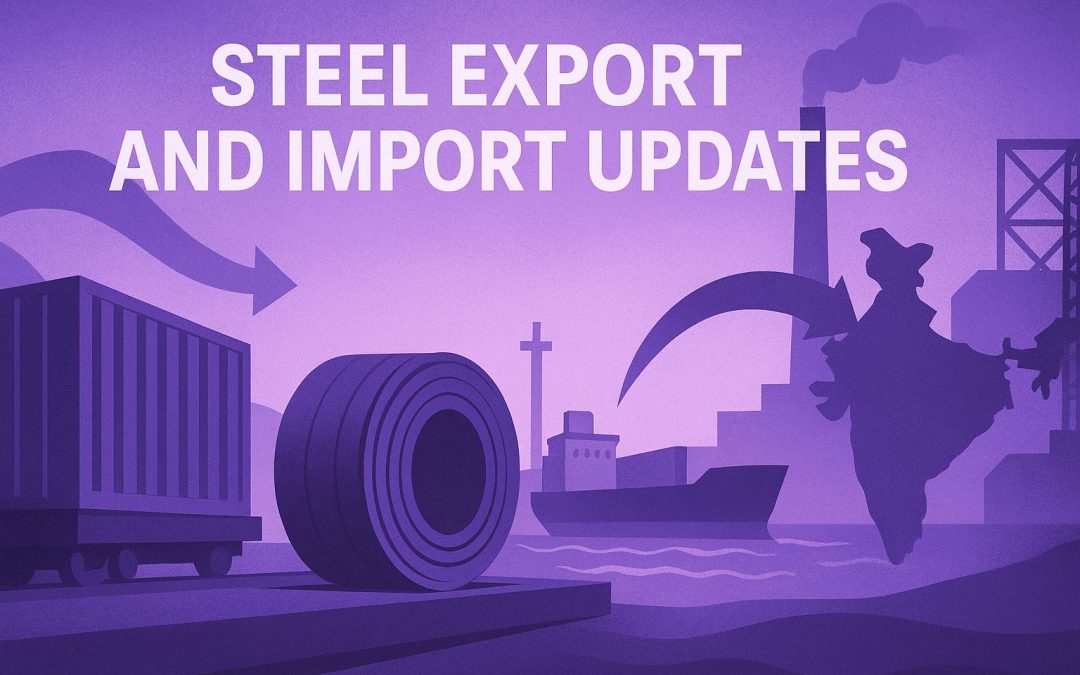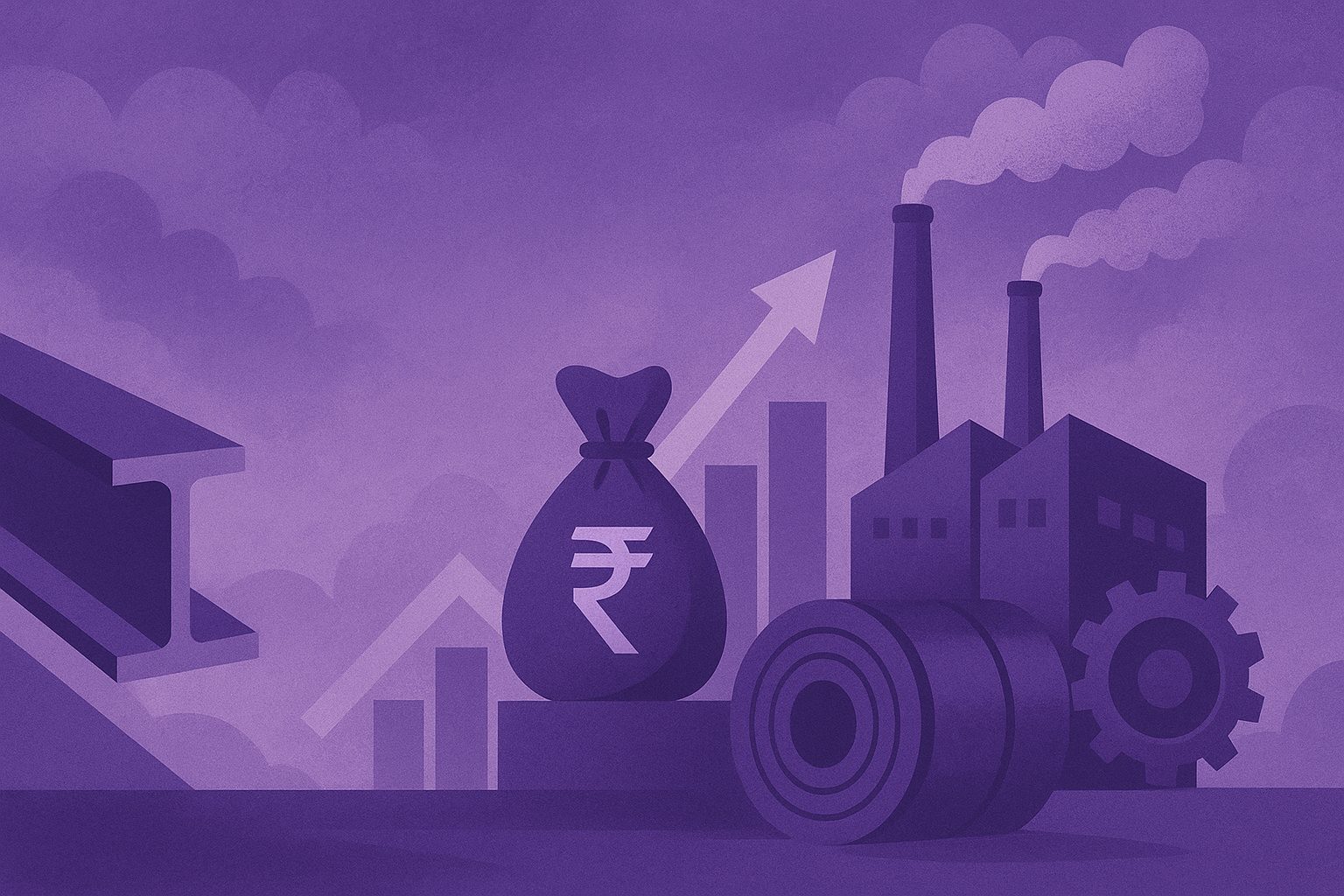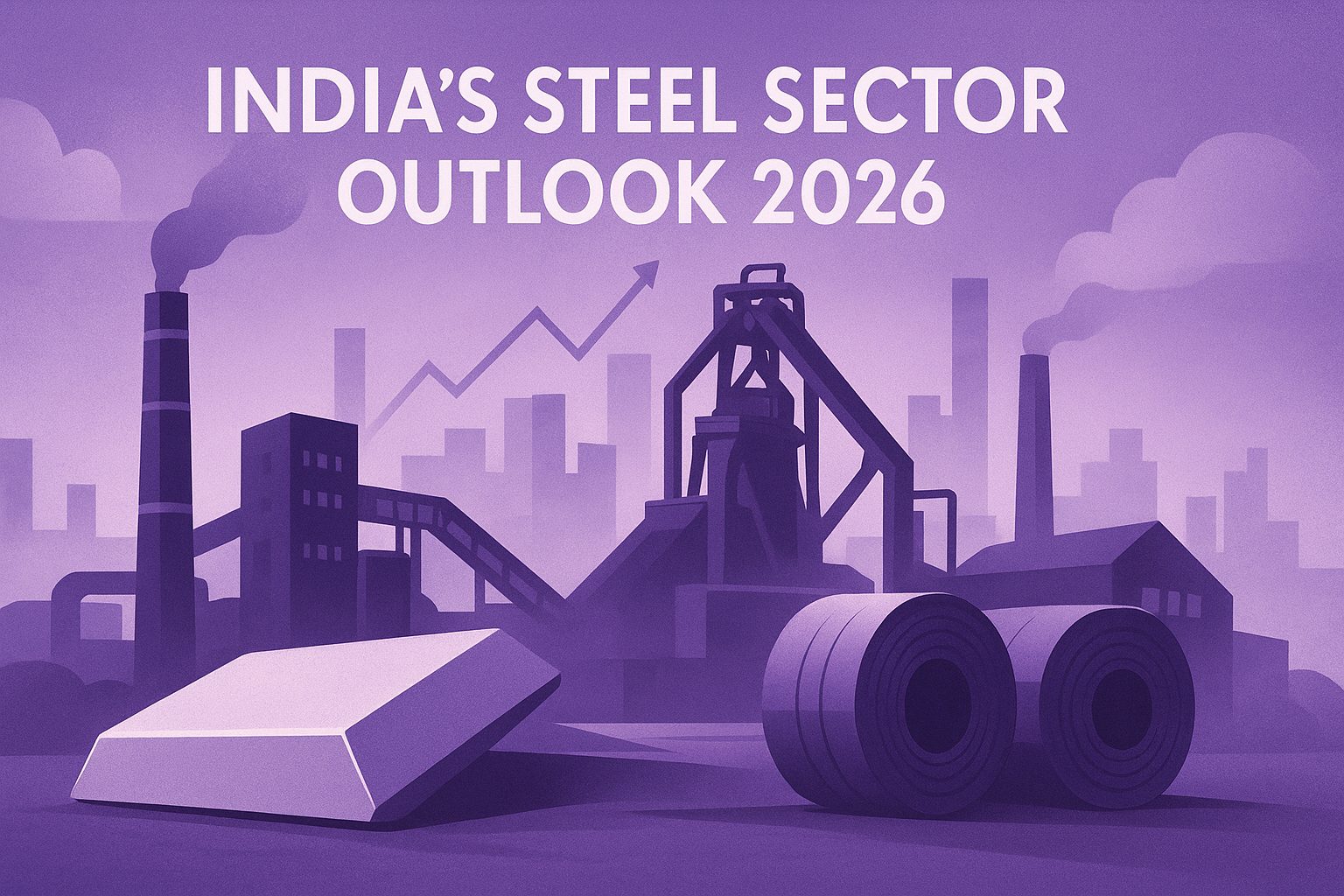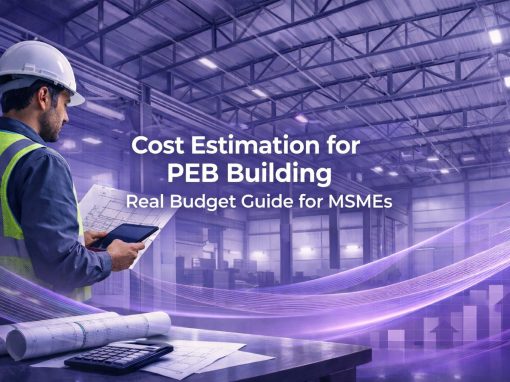Table of Contents
India is the second-largest producer of crude steel in the world, with an output of 149.4 million tonnes in 2024, according to WorldSteel.org. The country’s steel industry continues to play a key role in national infrastructure and exports. For FY25–26, finished steel consumption is expected to grow by 9–10%, supported by strong demand from construction, manufacturing, and energy sectors. However, the balance between steel export and import remains a concern.
India has turned a net importer of steel multiple times in the past year, driven by increased inflows from China and trade diversions from Western markets. These trends have prompted the government to consider safeguarding duties and tighter trade controls to support domestic producers.
Steel Import Updates – Data and Figures
India’s steel imports have seen strong fluctuations through FY24–25. According to Reuters (Apr 2025) and SteelOrbis (May 2025), the country imported around 9.5 million tonnes (Mt) of steel in FY24–25, marking a 14.6% year-on-year increase.
Between April and December 2024, imports rose sharply to 7.27 Mt, up 20.3% compared with the same period in the previous year. However, in April–May 2025, imports fell by 27.6% year-on-year to 0.9 Mt, showing a brief slowdown in demand.
Much of the import growth in FY24–25 was driven by non-alloyed steel, which made up the largest share of incoming shipments. Meanwhile, alloyed and stainless steel imports declined slightly due to lower industrial consumption.
The continued rise in imports, especially from China, has raised concerns among domestic steelmakers. The Indian Steel Association (ISA) has urged the government to monitor these inflows closely, citing the risk of cheaper foreign steel undercutting local producers and impacting market prices.
Steel Export Updates – Data and Figures
India’s steel exports declined notably in FY 2024–25, totalling about 4.9 million tonnes (Mt) — a 35% drop year-on-year, according to SteelOrbis (Apr 2025). The fall was mainly driven by weaker global demand and higher competition from low-cost producers such as China and Vietnam.
In value terms, India’s iron and steel exports were around US $10.2 billion during 2024. European countries like Italy, Spain, and Belgium remained key buyers, though shipment volumes were lower than the previous year.
Flat steel products continued to dominate India’s export basket, while exports of alloyed and stainless steel saw a sharp dip due to slower orders from automotive and construction sectors abroad.
The EU carbon border tax, which began its transition phase in late 2024, is expected to further affect India’s steel exports in 2025, as exporters adjust to stricter carbon reporting and pricing requirements.
Overall, India’s steel exports in 2025 are expected to remain subdued unless demand recovers in major markets or trade conditions ease.
India’s Steel Export–Import Overview (FY 2023–2025)
| Category | FY 2023–2024 | FY 2024–2025 | Change (YoY) | Key Notes/Sources |
| Crude Steel Production | 145.3 Mt | 149.4 Mt | +2.8% | India remains 2nd largest global producer (WorldSteel.org, Nov 2025) |
| Finished Steel Consumption | 117 Mt | 128 Mt (Est.) | +9–10% | Strong infrastructure and manufacturing demand |
| Steel Imports (Total) | 8.29 Mt | 9.5 Mt | +14.6% | Driven by non-alloyed steel; China key source (Reuters Apr 2025, SteelOrbis May 2025) |
| Steel Imports (Apr–Dec 2024) | 6.05 Mt | 7.27 Mt | +20.3% | Reflects strong inbound trade pre-FY close |
| Steel Imports (Apr–May 2025) | 1.24 Mt | 0.9 Mt | –27.6% | Temporary slowdown in early FY 2025–26 |
| Steel Exports (Total) | 7.55 Mt | 4.9 Mt | –35% | Decline due to weak global demand (SteelOrbis Apr 2025) |
| Iron & Steel Export Value | US $14.6 Bn | US $10.2 Bn | –30% | Global prices and EU carbon levy weigh on margins |
| Top Export Destinations | Italy, Spain, Belgium | Italy, Spain, Belgium | — | EU remains key buyer block |
| Top Import Sources | China, South Korea, Japan | China ↑, South Korea ↓ | — | Chinese shipments surge, price-driven |
Quick Insights
- India remained the world’s #2 steel producer through 2025.
- Imports rose strongly despite safeguarding duties, while exports contracted sharply.
- China overtook South Korea as the largest steel supplier to India in 2025.
- Exports to Europe face new carbon tax pressures and soft construction demand.
India’s Steel Trade Value – Exports and Imports (US $)
India’s iron and steel trade shows a widening gap between exports and imports in 2024, according to Trading Economics (2025).
In 2024, India’s iron and steel exports were valued at about US $ 10.18 billion, reflecting lower shipment volumes and softer global steel prices. In contrast, imports reached US $ 17.42 billion, highlighting stronger domestic demand for specific grades of finished and flat steel that are not widely available in India.
This difference indicates a trade deficit of more than US $ 7 billion in the steel segment. The deficit has been widening since mid-2023 as import costs increased and export volumes fell due to weaker orders from Europe and Asia.
Rising inflows from China, Japan, and South Korea continue to dominate India’s import basket, while Italy, Spain, and Belgium remain the largest destinations for Indian exports. Policymakers are monitoring this imbalance closely as it affects the domestic price outlook and overall trade performance for FY 2025–26.
India’s Steel Product Breakdown – Imports and Exports (2025)
| Category | Product Type | Share/ Change | Trend/Insight |
| Imports | Flat Steel Products (HRC, CRC, Plates, Sheets) | Dominant share of imports. | Key materials for automotive, appliance, and engineering sectors. |
| Non-alloyed Steel | ≈ 70% of total imports | Most-imported steel category; used widely in manufacturing. | |
| Alloyed & Stainless Steel | Minor share; slight decline (–8% YoY) | Lower demand from construction and heavy industry. | |
| Exports | Flat Products (HRC, Plates) | –68% in H1 CY 2025 | Sharp fall due to weak global demand, especially from Europe & SE Asia. |
| Long Products (Bars, Rods, Structural Steel) | Small positive growth (+3–4%) | Boosted by niche infrastructure projects abroad. | |
| Overall Insight | India’s import basket is dominated by flat, non-alloyed steel, while its export basket is narrowing due to weak global prices. |
India’s Steel Trade by Country
India’s steel trade in 2025 shows a shift in both import and export destinations, according to Reuters (Jul–Sep 2025).
On the import side, shipments from China fell by about 48% during April–May 2025, while imports from Japan dropped by around 66% in the same period. This decline followed India’s safeguard duties and tighter monitoring of low-priced steel inflows.
Despite these reductions, China remains India’s single largest import source, followed by South Korea and Japan, supplying mainly flat and non-alloyed steel products.
On the export side, nearly two-thirds of India’s steel exports go to the European Union, with Italy, Spain, and Belgium being the top destinations. However, the EU carbon border tax and weaker construction activity continue to limit shipment growth to the region.
Overall, India’s 2025 trade pattern reflects a gradual pivot toward regional diversification, as exporters seek new markets in the Middle East and Southeast Asia to offset slower European demand.
India’s Steel Policy and Duty Impact Summary (2025–26)
| Timeline | Policy/Measure | Scope/ Products Affected | Expected Impact | |
| Mar 2025 | 12% Safeguard Duty | Non-alloy & alloy flat steel products | Short-term import slowdown; protection for domestic mills | |
| Mar–Sep 2025 (200 Days) | Temporary Duty Enforcement Period | Imports from China, Japan, South Korea | Importers adjust sourcing; trade flow rebalancing | |
| FY 2025–26 (Projection) | Import Volume Adjustment | All finished steel imports | Imports expected to halve due to levy, reducing dumping risk | |
| Ongoing Policy Focus | Domestic Steel Protection Strategy | Broad — flat & long steel categories | Strengthen local capacity; encourage “Make in India” manufacturing |
The 2025 safeguard duty marks a turning point in India’s steel trade policy, giving domestic producers short-term breathing space while rebalancing import dependencies.
India’s Steel Sector – 2026 Outlook and Global Impact
India’s steel industry is entering a period of transition shaped by both global and domestic factors. From October 2025, the EU Carbon Border Adjustment Mechanism (CBAM) will officially begin affecting exporters, according to Reuters (Sep 2025). This carbon tax is expected to raise the cost of Indian steel exports to Europe, especially for high-emission products like hot-rolled coils and plates. Exporters are now working to adopt cleaner technologies and track emissions to remain competitive in EU markets.
Domestically, India’s steel demand remains robust. As per SteelOrbis (Nov 2025) and Reuters (Apr 2025), finished steel consumption in FY 2025–26 is forecast to grow by 9–10%, supported by infrastructure spending, housing projects, and industrial growth. The government has also reaffirmed its crude steel capacity target of 300 million tonnes by FY 2030–31, signalling confidence in long-term sector expansion.
At the state level, Odisha, Jharkhand, and Chhattisgarh continue to anchor India’s steel output, hosting major integrated plants and new capacity projects. These states are likely to see higher investment inflows in 2026 as producers expand production and green-steel initiatives.
Overall, the India steel 2026 outlook points to steady domestic growth, cautious export performance due to EU policy shifts, and a strategic push toward sustainable production across leading steel-producing regions.
Business Implications
Importers:
- Face higher cost pressure due to the 12% safeguard duty on flat steel products.
- May need to renegotiate supply contracts or explore domestic alternatives to stay competitive.
Exporters:
- Must ensure EU carbon tax (CBAM) compliance starting October 2025.
- Will need stronger emission tracking and certification systems to retain EU market access.
Domestic Steel Producers:
- Benefit from rising demand — FY 2025–26 steel consumption forecast to grow 9–10%.
- Gain from import substitution and infrastructure-led expansion across key sectors.
- Opportunity to increase capacity utilisation and invest in green steel technologies.
Conclusion
India’s steel trade is entering a phase of major transition driven by evolving global demand and tighter policy measures. While export momentum has softened, strong domestic consumption and infrastructure growth continue to provide solid support. New import duties and the EU carbon tax are expected to reshape trade flows and raise cost pressures in FY 2025–26.
At the same time, producers are shifting focus toward green steel and higher-value segments as capacity expands. Overall, India’s steel sector remains resilient, adapting to global shifts while building on steady domestic momentum.
Looking to procure steel?
Tata nexarc helps manufacturers, builders and MSMEs source certified steel products, compare prices, and choose the right grade as per IS codes—with complete traceability and procurement confidence.
FAQs
Is India a net exporter or importer of steel in 2025?
How much did India’s steel imports grow in FY 2024–25?
Why did steel exports from India fall in 2025?
Which countries export the most steel to India?
Where does India export most of its steel?
What is the new safeguard duty on steel imports?
How has the EU Carbon Border Tax affected Indian steel exports?
What is India’s steel production and consumption outlook for 2026?
Which Indian states are key to steel production?
What opportunities lie ahead for domestic steel producers?
Priyanka is a seasoned content marketing professional with more than 6 years of experience crafting various forms of business and technology sector content. Her insightful writing tackles critical issues faced by small-scale manufacturing businesses. Priyanka's clear and concise communication empowers businesses to make informed decisions and thrive in today's dynamic business environment.







